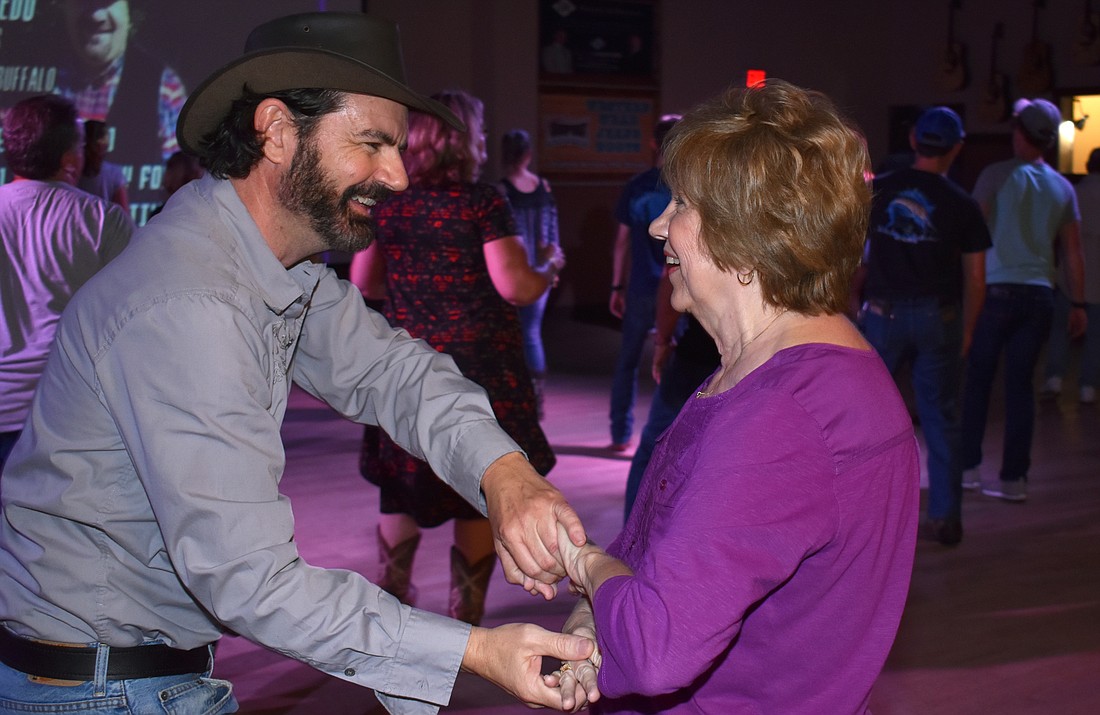- May 7, 2025
-
-
Loading

Loading

It’s an intimidating sight for anyone who’s rhythmically challenged.
It’s 6:30 p.m. on a hot Thursday night, and the dance floor at White Buffalo Saloon is crowded for Tim Schalch’s weekly line-dancing lesson.
Despite preconceived notions, it’s not all cowboy boots shuffling to the country beats DJ Chuck Reedy is sending through the thumping speakers. Sandal- and sneaker-donning guests of all ages — including seniors and an elementary-schooler — intently listen as Schalch demonstrates a series of steps.
His directions aren’t complicated, but the moves are tricky enough to get two-left-footed guests tripped up. Nobody seems too frustrated, though. They laugh at themselves and try again, unfazed.
“Nobody’s watching anyway — unless you make yourself noticeable,” Reedy says with a smile. “You can mess up a bit and get by.”
Schalch thinks of it as “choreographed walking” because he says you don’t have to be a great dancer to do it, you just need to learn the steps. Once dancers begin to get the hang of it, he says they realize many steps are used in several dances, so it gets easier to learn new ones.
Reedy has been the DJ at White Buffalo since it opened in January 2013, and he’s seen many of the same dancers hit the floor every week since. He estimates 20-30% of the people at the weekly lessons are regulars. The rest, he says, is a constant flow of new people.
When he talks logistics, the attraction begins to make sense.
Reedy points out that line dancing doesn’t require a partner, so it’s ideal for singles who want to go out dancing in a group or even alone.
It’s what first drew many of the regulars, and some have moved on to partner dancing.
Michael Raimondi was too terrified to step foot on the floor the first time he came to White Buffalo. Now, he can be found twirling other regulars, like Jean Rhoades and Adria Stasko, in circles around the dance floor several nights a week.
“I had a flight response for a good month,” Raimondi says. “I had to make myself stay on the floor.”
One of his dance partners cuts in.
“And if you see him dance now, you would never believe it,” Rhoades says. “If you have trouble with a dance, you go to Michael for help.”
It’s all a part of the culture of line dancing that’s alive and well at White Buffalo. It’s a community Raimondi says was willing to lend a helping hand. Now, he’s giving back by offering his help.
“We all mentor each other,” he says. “This is the closest thing I ever came to organized sports. I never did sports as a kid, and I’m now part of a team.”
And you don’t have to be a big country music fan to be part of that team.
“I did not like country music at all (before this),” says Rhoades. “I thought it was whiny and cranky and everything else. I had a few songs I liked, but I was mainly rock ‘n’ roll.”
Although country still makes up for about 80% of the songs played at White Buffalo, Schalch says incorporating pop songs and other non-traditional music has helped attract more dancers.
“It’s just something that everybody can do, and they can do it to any genre of music,” Schalch says. “It’s a good way to get people out of their comfort zone.”
Adria Stasko has been dancing for 25 years. Or, as she puts it, “since before it was cool.”
The Venice native has been coming to the White Buffalo since it opened and was a member of its official dance team.
She thinks one reason White Buffalo has such a loyal following is because it’s a respectable family institution. The bouncers strictly enforce the no-drinks-on-the-dance-floor policy, and women feel safe coming and leaving late at night.
For her, it’s truly a family affair.
“My daughter comes, and so I always say I’ve been dancing since she was in here,” she says while pointing to her stomach. “And now it’s something we do together. I love it.”